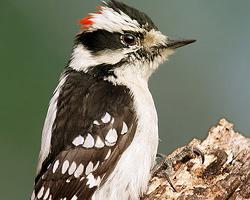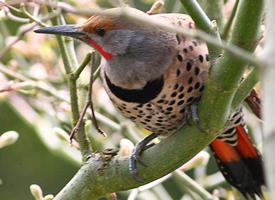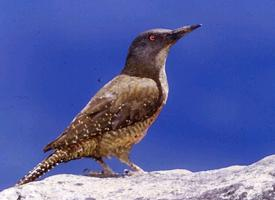
Váhy a míry
| Délka | od 17 do 17 cm |
|---|---|
| Hmotnost | od 21 do 28 g |
| Délka rozpětí křídel | od 25 do 30 cm |
Stav ohrožení
| Neohrožen |
Popis zvířete
The Downy Woodpecker (Dryobates pubescens) is a small, yet striking bird, renowned for its agility and distinctive markings. As one of the smallest woodpeckers in North America, it plays a vital role in the ecosystem, serving as both predator and prey. This bird is easily recognizable by its unique plumage and behavior, which have fascinated birdwatchers and nature enthusiasts for years.Physical Description:
The Downy Woodpecker measures approximately 14 to 18 centimeters in length, with a wingspan ranging from 25 to 30 centimeters, making it only slightly larger than a sparrow. Despite its small size, it possesses a robust, chisel-like bill that it uses effectively to drill into wood in search of insects. Its plumage is primarily black and white, with a striking contrast that makes it easily identifiable. The back is predominantly black with white spots, while the underparts are a soft white. The wings are black with white bars, and the tail is black with white outer feathers.
One of the most distinctive features of the Downy Woodpecker is the pattern on its head. Males have a small, vivid red patch on the back of their heads, which is absent in females. Both sexes have a white stripe down the back of their heads, a feature that distinguishes them from the similar but larger Hairy Woodpecker.
Behavior and Habitat:
The Downy Woodpecker is a versatile bird, adaptable to a variety of habitats, including deciduous and mixed forests, woodlands, orchards, parks, and suburban areas. It is primarily resident throughout its range, which covers most of North America, from Canada down to Florida and across to California.
This bird is known for its remarkable foraging technique. It uses its tail as a prop against tree trunks and branches as it searches for food, moving in an acrobatic manner that allows it to explore even the smallest branches. Its diet mainly consists of insects, including beetle larvae, ants, and caterpillars, which it extracts from crevices in the bark. It also consumes plant material, such as seeds, berries, and sap, particularly during the winter months when insects are less abundant.
Reproduction:
The breeding season for Downy Woodpeckers begins in late April to May. They are monogamous birds, often forming pairs that stay together throughout the year. The male and female work together to excavate a nest cavity in a dead tree or a dead portion of a living tree. The female lays 4 to 5 white eggs, which both parents incubate for about 12 days. After hatching, the chicks are altricial, meaning they are born blind and featherless. Both parents share the responsibility of feeding the chicks until they fledge, about 20-25 days after hatching.
Conservation Status:
Currently, the Downy Woodpecker is listed as Least Concern by the International Union for Conservation of Nature (IUCN), indicating it is not at immediate risk of extinction in the wild. Its population is stable and widespread, thanks in part to its adaptability to different habitats, including those altered by human activity. However, like all wildlife, it faces threats from habitat destruction and degradation.
In summary, the Downy Woodpecker is a fascinating and adaptable bird, easily recognizable by its distinctive plumage and behavior. Its presence is a delight to birdwatchers and an essential part of the ecosystem, contributing to the control of insect populations and the spreading of tree seeds.
Mapa výskytu

Podobná zvířata
Nové fotografie zvířat
Top 10 zvířat
- Chinese water dragon (Physignathus cocincinus)
- Dolphin gull (Leucophaeus scoresbii)
- Japanese macaque (Macaca fuscata)
- Galápagos tortoise (Geochelone nigra complex)
- Colombian red howler (Alouatta seniculus)
- Sea urchins (Echinoidea)
- Barbary macaque (Macaca sylvanus)
- Moustached guenon (Cercopithecus cephus)
- Diana monkey (Cercopithecus diana)
- Angolan talapoin (Miopithecus talapoin)


